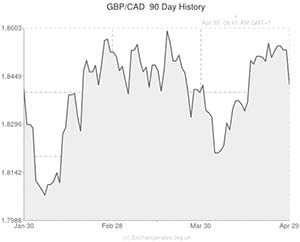
During North American trading the Canadian Dollar fluctuated following the release of domestic growth data. The currency edged lower against peers like the Pound and Euro.
Although Canada’s economy grew in the first quarter of the year, the pace of growth slowed.
According to figures compiled by Statistics Canada, national GDP advanced by 0.2 per cent in February, month-on-month, following growth of 0.5 per cent in January.
On the year GDP advanced 2.6 per cent in February, unchanged from January’s positively revised figure but stronger than the 2.5 per cent growth forecast.
A 4.8 per cent jump in mining and quarrying was largely responsible for the increase.
This report indicates that the Bank of Canada is pretty accurate with its estimate of annualised first quarter growth of 1.5 per cent.
The Pound to Canadian Dollar exchange rate (GBP to CAD) is currently trading around 1.8451.
Although the UK’s first quarter growth data fell short of expectations yesterday, the nation is still expected to perform better than its Group of Seven counterparts.
Canada’s economy, on the other hand, has been struggling to recover momentum and this lacklustre growth report did little to boost the Canadian Dollar against the Pound.
Additional data showed a smaller-than-expected increase in Canada’s industrial product and raw materials price index.
The industrial product price index rose by 0.4 per cent instead of 0.5 per cent while the raw materials price index advanced by 0.6 per cent rather than the 0.8 per cent projected.
Meanwhile, Bank of Canada Governor Stephen Poloz today asserted that Canada is losing out on roughly 40 billion Dollars in export sales as a result of uncompetitive producers.
The Canadian Dollar also came under pressure as US GDP figures confirmed that growth in the world’s largest economy slowed in the first quarter.
As the US is Canada’s largest trading partner the news that the US economy grew by an annualised 0.1 in the first quarter (considerably less than the 1.2 per cent growth expected) dampened Canada’s economic outlook and weighed on the local currency.
Later today the Federal Open Market Committee will deliver its rate decision. Given the US growth figures it seems increasingly likely that the Fed will maintain a dovish approach when it comes to fiscal policy. If that proves to be the case the US Dollar could fall further.
Tomorrow sees the publication of Canadian manufacturing data for April. The RBC gauge came in at 53.3 last month, above the 50 mark separating growth from contraction. Another month of good expansion may lend the ‘Loonie’ some support.
Canadian Dollar (CAD) Exchange Rates
[table width=”100%” colwidth=”50|50|50|50|50″ colalign=”left|left|left|left|left”]
Currency, ,Currency,Rate ,
Canadian Dollar, ,Pound Sterling,0.5417,
,Pound Sterling,0.5417,
Canadian Dollar, ,US Dollar,0.9129,
,US Dollar,0.9129,
Canadian Dollar, ,Euro,0.6587,
,Euro,0.6587,
Canadian Dollar, ,Australian Dollar,0.9837,
,Australian Dollar,0.9837,
Canadian Dollar, ,New Zealand Dollar,1.0567,
,New Zealand Dollar,1.0567,
US Dollar, ,Canadian Dollar ,1.0954,
,Canadian Dollar ,1.0954,
Pound Sterling, ,Canadian Dollar,1.8451,
,Canadian Dollar,1.8451,
Euro, ,Canadian Dollar,1.5194,
,Canadian Dollar,1.5194,
Australian Dollar, ,Canadian Dollar,1.0166,
,Canadian Dollar,1.0166,
New Zealand Dollar, ,Canadian Dollar,0.9463,
,Canadian Dollar,0.9463,
[/table]

Comments are closed.